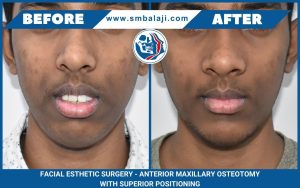Initial Presentation
This young man from Yangon, Myanmar, had been born with a cleft lip and palate and had undergone cleft repair as an infant. He had subsequently developed velopharyngeal incompetence, where there is escape of air through the nose during speech. This had lead to him having difficulty pronouncing certain words well and he also had a nasal twang to his voice. He had very limited mouth opening. He presented to Balaji Dental and Craniofacial Hospital, Teynampet, Chennai for surgical correction of his speech difficulties. He had been referred to a speech pathologist who advised him for a sphincter pharyngoplasty surgery to correct his velopharyngeal incompetence/hypernasality.
Treatment Planning and Surgery
Dr SM Balaji, Cranio-Maxillofacial Surgeon, examined him and advised him that he needed a pharyngoplasty surgery for correction of his problem. The patient agreed to this and was scheduled for surgery. This surgery is performed for the creation of a dynamic sphincter in the pharynx by repositioning of the palatopharyngeus muscle. The patient was taken to the operating room and underwent general anesthesia without complications. Incisions were made to release the posterior faucial pillars, including the palatopharyngeus muscle. These were then crisscrossed and sutured together on the posterior pharyngeal wall.
This formed a sphincter along with the formation of a small opening or “port” for the patient to breathe through his nose. Though his mouth opening was very limited, his sphincter pharyngoplasty was very successful.
Successful Positive Suction Test Demonstrates Successful Surgery
Successful demonstration of a positive suction test at the completion of the surgery revealed a dynamic velopharyngeal sphincter action thus indicating successful correction of his velopharyngeal incompetence. The patient was then extubated and recovered from general anesthesia without complications.






Discussion
I am a lady of 35yrs old. I went for plastic surgery on the bilateral cleft palate up to the level of pharyngoplasty but Still have much gap on the soft palate which occurs velopharyngeal incompetence when pronounce some speech sounds. This problem has been scared men away of getting married to me. Let me know what I should do.
Send your details with contact number to smbalaji@gmail.com